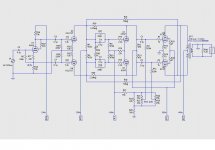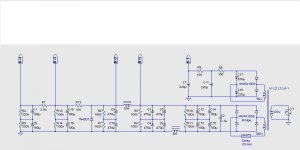First, let me apologize for the length of this post but I thought it might be of interest to several members.
I have been using an all-balanced circuit, consisting of 6SL7 LTP splitter with 6AU6 pentode CCS in the tail, 6SN7 differential driver and EL34/6CA7 PP in triode mode. Negative feedback is achieved using cross-coupled partial FB from EL34 plates to 6SL7 plates. This circuit has sufficient open-loop gain to be able to apply a reasonable amount of NFB.
Although it's tempting to use a feedback-free circuit with triode output tubes, I need the additional damping for my speakers. In any case, the EL34 isn't quite as "clean" as a true triode, such as 300B, so I consider that the odd order harmonics need to be suppressd with NFB. The results are very good and there is no risk of instability, since the OPT is outside the loop.
I was wondering if a similar design could be used with the EL34s in pentode mode, to get almost triple the output power. My OPTs don't have UL taps, so that option is out. However, they can give the 3.5k p-p loading required for pentode mode.
The big drawback with pentodes is that they have a very high output impedance (15x that of the same tubes in triode mode). This means a lot morfe NFB is required to get an acceptable damping factor. The usual global loop can be used but it has the disadvantage of introducing instability problems that have to be fixed with correctional networks and that is very dependant upon the quality of the OPT.
My cross-coupled NFB circuit avoids most of the instability problems but it cannot really provide enough gain to be able to pile on the amount of NFB required withou ending up with a very low closed-loop gain. Input sensitivity would end up at about 1.6v, which is not enough for my purposes.
However, it occurred to me that, by using the 6SL7 as an LTP splitter, I was losing half the gain from the first stage. So, What if a separate splitter were to be used as a front end? The 6SL7 could then give its full gain and the input sensitivity would be nearer my requirements.
I could redeploy the 6AU6 in triode mode as a concertina splitter for this purpose, since it would no longer be needed as a CCS. In fact, the 6SL7 would be probably be better connected in push-pull mode than differential mode, more appropriate for its role as the input to a partial feedback circuit. At teh same time, I could add an additional local NFB loop between the 6SN7 and 6SL7 plates, to assist with balance and to make the step network between the two stages more effective for NFB stability purposes.
The resulting schematic is attached. I haven't built it yet but it models very well with LTSpice. The power supply, intended to feed both channels, is attached to the post following this one. Sensitivity is 875mv for 45 watts output and DF is about 8. Stability appears to be excellent, band-with is falt from 20Hz to 20kHz and 10kHz square-wave is clean. All these "results" are obtained from the LTSpice model, of course, since I haven't built it yet. However, one of the biggest potential pitfalls, namely, the quality of the OPT, is not a worry since it is outside the NFB loop.
Comments welcome!
I have been using an all-balanced circuit, consisting of 6SL7 LTP splitter with 6AU6 pentode CCS in the tail, 6SN7 differential driver and EL34/6CA7 PP in triode mode. Negative feedback is achieved using cross-coupled partial FB from EL34 plates to 6SL7 plates. This circuit has sufficient open-loop gain to be able to apply a reasonable amount of NFB.
Although it's tempting to use a feedback-free circuit with triode output tubes, I need the additional damping for my speakers. In any case, the EL34 isn't quite as "clean" as a true triode, such as 300B, so I consider that the odd order harmonics need to be suppressd with NFB. The results are very good and there is no risk of instability, since the OPT is outside the loop.
I was wondering if a similar design could be used with the EL34s in pentode mode, to get almost triple the output power. My OPTs don't have UL taps, so that option is out. However, they can give the 3.5k p-p loading required for pentode mode.
The big drawback with pentodes is that they have a very high output impedance (15x that of the same tubes in triode mode). This means a lot morfe NFB is required to get an acceptable damping factor. The usual global loop can be used but it has the disadvantage of introducing instability problems that have to be fixed with correctional networks and that is very dependant upon the quality of the OPT.
My cross-coupled NFB circuit avoids most of the instability problems but it cannot really provide enough gain to be able to pile on the amount of NFB required withou ending up with a very low closed-loop gain. Input sensitivity would end up at about 1.6v, which is not enough for my purposes.
However, it occurred to me that, by using the 6SL7 as an LTP splitter, I was losing half the gain from the first stage. So, What if a separate splitter were to be used as a front end? The 6SL7 could then give its full gain and the input sensitivity would be nearer my requirements.
I could redeploy the 6AU6 in triode mode as a concertina splitter for this purpose, since it would no longer be needed as a CCS. In fact, the 6SL7 would be probably be better connected in push-pull mode than differential mode, more appropriate for its role as the input to a partial feedback circuit. At teh same time, I could add an additional local NFB loop between the 6SN7 and 6SL7 plates, to assist with balance and to make the step network between the two stages more effective for NFB stability purposes.
The resulting schematic is attached. I haven't built it yet but it models very well with LTSpice. The power supply, intended to feed both channels, is attached to the post following this one. Sensitivity is 875mv for 45 watts output and DF is about 8. Stability appears to be excellent, band-with is falt from 20Hz to 20kHz and 10kHz square-wave is clean. All these "results" are obtained from the LTSpice model, of course, since I haven't built it yet. However, one of the biggest potential pitfalls, namely, the quality of the OPT, is not a worry since it is outside the NFB loop.
Comments welcome!
Attachments
I thought more than a dozen stages in an amp was no longer en vogue 🙂
Haven't ARC already developed enough amps with similar topology?
Haven't ARC already developed enough amps with similar topology?
I thought more than a dozen stages in an amp was no longer en vogue
True, that's the main reason I didn't use "more than a dozen" stages 🙄 . Actually, there are only 2 stages inside the loop (6SN7 and EL34). It's a fully-balanced amp, with a splitter on the front (which would not be needed if I had a balanced signal coming in). I could have used a more "politcally correct" transformer as the splitter, which, one suspects, might have gone down better, but I don't have one and I don't like them much anyway.
Haven't ARC already developed enough amps with similar topology?
Dunno, never seen an ARC amp. In any case, that's not DIY now, is it?

- Status
- Not open for further replies.

